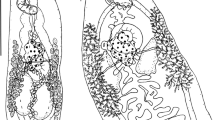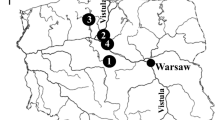Summary
Out of 30 species of Oribatids (from 23 genera), which were provided with eggs ofCtenotaenia marmotae in the laboratory, 24 proved to be potential intermediate hosts. The course of development of the parasite in the intermediate host could be followed up as far as to the cysticercoid (Figs. 2–8). It largely corresponds to the development of other Anoplocephalidae. After 113 days p.i. (test temperature 18–20° C) the cysticercoid stage was reached.
In the Pölla valley (Carinthia), at a sea level of 2,200 m, the droppings of marmots scattered on the grass and mingled with proglottids ofC. marmotae were marked. 9 months later 24 grass samples were taken and examined as to infected Oribatids. Out of a total of 12,100 specimens 49 turned out to be infected with cysticercoids; these specimens, however, belong to the species ofTrichoribates incisellus (Kramer) andTrichoribates trimaculatus (C.L. Koch). They were taken from 16 samples with a total of 8,400 Oribatids. This is the first evidence under natural conditions of Oribatids acting as intermediate hosts toC. marmotae. It is presumed that 2 seasonal invasion peaks occur in the final hostMarmota marmota (L.).
Zusammenfassung
Von 30 Oribatidenarten (aus 23 Gattungen), denen im Labor Eier vonCtenotaenia marmotae angeboten wurden, erwiesen sich 24 als potentielle Zwischenwirte. Der Entwicklungsverlauf des Parasiten im Zwischenwirt konnte bis zum Cysticercoid verfolgt werden. Er entspricht weitestgehend der Entwicklung anderer Anoplocephaliden. Bei einer Versuchstemperatur von 18–20°C war nach 113 Tagen p.i. das Cysticercoid-Stadium erreicht.
Im Pöllatal (Kärnten) wurde in 2,200 m über NN frei auf dem Rasen liegende und mit Proglottiden vonC. marmotae durchsetzte Murmeltierlosung zur Markierung mit Steinwällen (Durchmesser ca. 50×50 cm) umgeben. 9 Monate später wurden 24 Rasenproben entnommen und auf infizierte Oribatiden hin untersucht. Von 12,100 Individuen (24 Proben) waren 49 (16 Proben) mit Cysticercoiden infiziert; der Befall beschränkte sich aufTrichoribates incisellus (Kramer) undTrichoribates trimaculatus (C. L. Koch). Es ist dies der erste Freilandnachweis für Oribatiden als Zwischenwirte vonCtenotaenia marmotae. Das Auftreten von 2 saisonalen Invasionsmaxima im Endwirt,Marmota marmota (L.), ist anzunehmen.
Similar content being viewed by others
Literatur
Balogh, J.: Identification keys of holarctic oribatid mites (Acari) families and genera. Acta zool. Acad. Sci. hung.9, 1–60 (1963).
Blanchard, R.: Experiences et observations sur la marmotte en hibernation. C. R. Soc. Biol. (Paris)55, 734–741, 1120–1126, (1903)
Caley, J.: In vitro hatching of the tapewormMoniezia expansa (Cestoda: Anoplocephalidae) and some properties of the egg membranes. Z. Parasitenk.45, 335–446 (1975)
Dogiel, V. A.: Allgemeine Parasitologie. Parasit. Schriftenreihe, Jena: VEB Gustav Fischer 1963
Ebermann, E.: Oribatiden als Zwischenwirte des BandwurmesHymenolepis asymetrica Janitzki, 1904 (Hymenolepididae). Zool. Jb. Syst.103, 105–116 (1976).
Freeman, R. S.: The biology and life history ofMonoecocestus Beddard, 1914 (Cestoda, Anoplocephalidae) from the porcupine. J. Parasit.38, 111–129 (1952).
Galli-Valerio, B.: IstAphodius obscurus Fabr. der Zwischenwirt vonCittotaenia marmotae Braun?. Schweiz. Arch. Tierheilk.60, 551–553 (1918)
Galli-Valerio, B.: Über einen Cysticerkus beiSphaeridium scarabaeoides L. Zbl. Bakt., I. Abt. Orig.94, 63 (1925).
Galli-Valerio, B.: Sur le cycle évolutif des Anoplocephalinées. Zbl. Bakt., I. Abt. Orig.129, 431–432 (1933).
Hammen, L. van der: The Oribatei (Acari) of the Netherlands. Zool. Verh. Leiden17, 1–139 (1952).
Hörning, B.: Parasitologische Untersuchungen an Alpenmurmeltieren (Marmota marmota) der Schweiz. Jb. naturhist. Mus. Bern 137–200 (1969).
Hörning, B., Tenora, F.: Über den heutigen Stand der Erforschung von Bandwürmern aus Murmeltieren (GattungMarmota). Věstn. společ. zool.35, 103–106 (1971)
Jettmar, H.M., Anschau, M.: Beobachtungen an Parasiten steirischer Murmeltiere. Z. Tropen-med. Parasit.2, 412–428 (1951)
Kassai, T., Mahunka, C.: Studies on tapeworms in ruminants. II. Oribatids as intermediate hosts ofMoniezia species. Acta vet. Acad. Sci. hung.15, 227–249 (1965)
Krull, W. H.: Observations on the distribution and ecology of the oribatid mites. J. Wash. Acad. Sci.29, 519–528 (1939b)
Menke, H. G.: Revision der Ceratozetidae.Ceratozetes peritus Grandjean (Arach., Acari, Oribatei). Senck. biol.45, 141–154 (1963)
Menke, H. G.: Revision der Ceratozetidae. 2.Ceratozetes gracilis (Michael) (Arach., Acari, Oribatei). Senck. biol.45, 621–634 (1964).
Pschorn-Walcher, H.: Zur Biologie und Systematik terricoler Milben. I. Die ostalpinen Arten der GattungLiacarus Mich. (Oribatei). Bonn. Zool. Beitr.2, 177–184 (1951).
Rayski, C.: Observations on the life history ofMoniezia with special reference to the bionomics of the oribatid mites. Rep. 14th Int. Vet. Congr. LondonII, 51–55 (1949).
Sellnick, M., Forsslund, K. H.: Die Camisiidae Schwedens (Acar. Oribat.) Ark. Zool. II,8, 473–530 (1955).
Sixl, W.: Zur Parasitierung des MurmeltieresMarmota marmota (Linné 1758). Carinthia II84, 311 (1974)
Stunkard, H. W.: Studies on the life history of the anoplocephaline cestodes of hares and rabbits. J. Parasit.27, 299–325 (1941)
Tenora,F., Hörning, B.: Die Bandwürmer der GattungCtenotaenia Railliet, 1893 (Cestoidea) — Parasiten von Säugetieren der GattungMarmota (Rodentia). Acta Univ. Agric., Ser. A.XX, 139–146 (1972).
Voge, M., Heyneman, D.: Development ofHymenolepis nana andHymenolepis diminuta (Cestoda: Hymenolepididae) in the intermediate hostTribolium confusum. Univ. Calif. Publ. Zool.59, 549–564 (1957).
Willmann, C.: Moosmilben oder Oribatei. In: Dahl, Tierwelt Deutschlands. 22. Teil, S. 79–200. Jena: Fischer 1931.
Author information
Authors and Affiliations
Additional information
Subventioniert aus Mitteln der “Landeshygiene für den Umweltschutz in Steiermark”
Rights and permissions
About this article
Cite this article
Ebermann, E. Oribatiden (Oribatei, Acari) als Zwischenwirte des Murmeltier-BandwurmesCtenotaenia marmotae (Frölich, 1802). Z. F. Parasitenkunde 50, 303–312 (1976). https://doi.org/10.1007/BF02462974
Received:
Issue Date:
DOI: https://doi.org/10.1007/BF02462974




